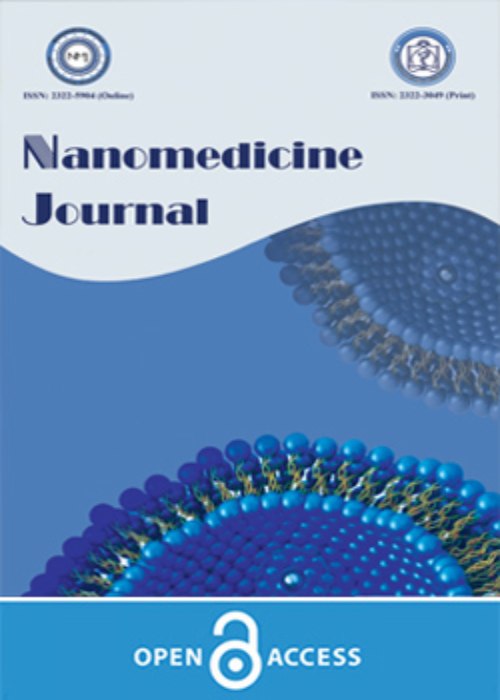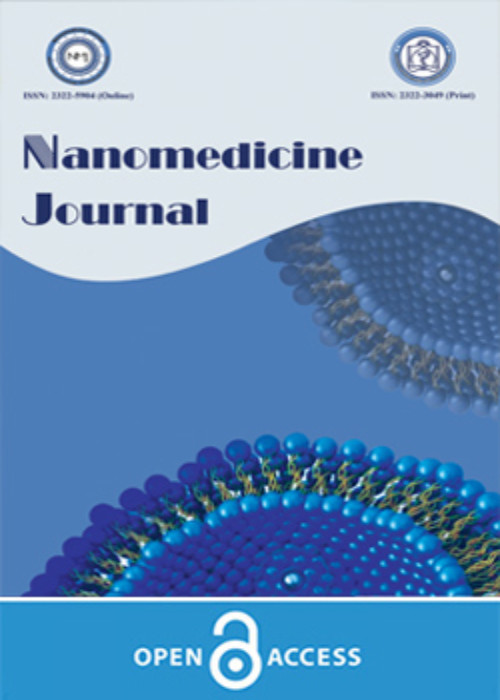فهرست مطالب

Nanomedicine Journal
Volume:10 Issue: 4, Autumn 2023
- تاریخ انتشار: 1402/07/09
- تعداد عناوین: 8
-
-
Pages 259-270
Today, the nanotechnology science is wide and it has entered nearly all scientific fields. One of the most important applications of nanotechnology is in medicine, especially in diagnosis of microbes (such as bacteria, fungi and viruses) and treatment of the infections caused by them. Yearly, the microbial infections lead to many medical problems such as increased duration of treatment, increased expenses of treatment, drag resistances, and even increased mortality. Since many years ago, antibiotics have been used in treatment of various infections, but unfortunately, their side effects as well as the resistance to them have always been the key problems. Thus, selection of the most suitable detection methods as well as the most appropriate treatment options for various microbial infections may reduce the crisis. It seems that nanotechnology approaches may efficiently help to diagnose many different microbial infections as well as to combat them, particularly the resistant ones, with no side effects currently caused by the traditional antibiotics.
Keywords: Diagnosis, Microbiology, Nanotechnology, Treatment -
Pages 271-278Objective (s)
This study investigates the effect of naonoliposmal encapsulated hybrid extract (NEHE) obtained from three plants (green tea, garlic, and chicory) in treating diabetes through expression of PPARgamma, BGK, and GLUT2 genes involved in diabetes and their relationship with miR-27a.
Materials and MethodsHerbal extracts were encapsulated in liposome. RIN-5F cells were exposed to streptozotocin (STZ) for 24 hr and divided into five groups to induce the diabetes model. Three groups received 0.4, 1, and 2 mg/ml of NEHE, a positive control group received 5 µg/ml of metformin for 72 hr, and a negative control group was only treated with FBS. Then, they were subjected to an MTT assay to check the toxicity of the extract. An immunohistochemical test was performed to check the level of insulin expression in different groups. Real Time-PCR test was performed to check the expression of desired genes.
ResultsMTT assay showed that the NEHE extract had no toxicity on the tested cells. Also, the immunohistochemistry results showed that insulin expression NEHE group was significantly higher than that of the metformin group (P<0.001), indicating the antidiabetic effect of the extract. In all groups treated with the extract, especially with the maximum extract concentration, the expression level of BGK, PPARgamma, miR-27a, and GLUT2 genes was significantly higher than that of the untreated control group. Furthermore, there was no significant difference in the expression of BGK and PPARgamma genes in groups trated with either metformin or plant extract at concentration of 2 mg/ml groups. NEHE showed an improved effect in treating diabetes in a dose-dependent manner by increasing insulin secretion from pancreatic cells.
ConclusionAs a glucose transporter and sensor, GLUT2 controls the balance between intracellular and extracellular glucose concentrations. When glucose-induced insulin secretion is impaired, garlic can increase the half-life of insulin, while green tea and chicory reduce insulin resistance through the miR-27a pathway.
Keywords: BGK, Diabetes, GLUT2, Herbal extract, miR-27a, PPARgamma -
Pages 279-292Objective (s)
This study aimed to synthesize Samarium-doped TiO2 nanoparticles (Ti(Sm)O2 NPs) using solvothermal synthesis and evaluate their suitability as targeted imaging agents. The objectives were to enhance the stability and biocompatibility of the nanoparticles by coating them with polymeric materials and assess their imaging capabilities and safety.
Materials and MethodsTi(Sm)O2 NPs were synthesized using the solvothermal method with TiO2, NaOH, and deionized water. The resulting solution was filtered, dried, and processed in a Teflon-lined stainless steel autoclave. The obtained product was washed, dried, and coated with FDA-approved polymers including polyethylene glycol (PEG), polyvinylpyrrolidone (PVP), and carboxymethyl cellulose (CMC). Coating was achieved through a mixing process and subsequent drying.
ResultsCharacterization studies confirmed the desired morphology, crystal structure, optical properties, surface charge, and biocompatibility of the Ti(Sm)O2 NPs. In vivo imaging evaluations demonstrated their excellent imaging capabilities, particularly in distinguishing lung pathologies. Additionally, in vivo toxicity studies confirmed the nanoparticles biocompatibility and safety, with no adverse effects on organ function observed.
ConclusionIn this study, Samarium-doped TiO2 nanoparticles WERE successfully synthesized and their potential as targeted imaging agents was evaluated. The coating of the nanoparticles with polymeric materials enhanced their stability and biocompatibility. The nanoparticles exhibited excellent imaging capabilities, particularly in distinguishing lung pathologies. Moreover, they demonstrated biocompatibility and safety in vivo. These findings contribute to the development of advanced contrast agents for biomedical applications, providing effective tools for targeted imaging and improving the diagnosis and monitoring of various lung pathologies.
Keywords: Biopolymers, Contrast media, Drug-related side effects, adverse, Polyethylene glycols, Samarium, Titanium dioxide, x-rays -
Pages 293-303Objective (s)
Herbal compounds with cytotoxicity have been of great interest in recent years to improve cancer treatment methods. Fisetin is an anti-cancer herbal compound with low solubility in aqueous systems. Metformin is another compound with anti-cancer effects. In this study, the combined effect of fisetin and metformin was investigated using mesoporous silica nanoparticles (MSNs) in breast cancer cell lines.
Materials and MethodsAfter the synthesis of nanoparticles, they were characterized using XRD, TEM, SEM. The DLS test showed a size of 143.4 nm with zeta-potential -39.1 mV. Fisetin and metformin were loaded into nanoparticles and loading was confirmed by FTIR. The toxicity of different concentrations of free drug (metformin, fisetin, fisetin-metformin) and Nanoformulations (metformin, fisetin and nano-fisetin-metformin) was investigated on two breast cancer lines MCF7 and MDA-MB-231.
ResultsFisetin-metformin co-loaded in MSNs showed the highest cytotoxicity among all formulations in both cell lines. The inhibition of colony formation and migration rate was effectively observed in the co-treatment of cells with fisetin and metformin loaded in nanoparticles compared to single treatments. The expression of tumor suppressor miR-200b-3p and miR-34a-5p showed that fisetin increased the expression of these tumor suppressors compared to the control.
ConclusionThe anti-cancer effect of fisetin-metformin in combination increased the expression of tumor suppressors due to the regulation of a wide range of gene network involving in cancer progress. The obtained results highlight the use of MSN as an effective drug delivery system for simultaneous delivery of herbal cytotoxic compounds in cancer.
Keywords: Breast Cancer, Drug delivery systems, Flavonols, Metformin, Nanoparticles -
Pages 304-312Objective (s)
In this study, ocular drug delivery systems with a dispersed lipid liquid crystal (cubosomes) containing fluorometholone were used for sustained release and increased permeability to the eye.
Materials and MethodsTo obtain the best Cubosomes, 6 formulations (F) were prepared. To prepare the F1, glycerol monooleate (GMO) and water containing fluorometholone were vortexed. After one week, when the liquid crystal gel formed, 0.5 g of the liquid crystal gel was added to 9.5 g of a 1% (w/w%) aqueous solution of Polaxamer F-127, and the mixture were homogenized and sonicated.
ResultsThe data showed that increasing the weight of gel from 0.5 g to 1.0 g (F2) did not result in a significant increase in drug loading, indicating that increasing the GMO concentration did not affect drug loading. The addition of cyclodextrin to the formulation (F3), along with an increase in cyclodextrin concentration from a molar ratio of 5:1 to 10:1 (F4), did not create a significant alternation in drug loading. Furthermore, the addition of phosphatidyl choline (PC) to the GMO (F5) did not cause a significant change in drug loading. Finally, in formulation F6 ( in which GMO, Polaxamer, and the drug was dissolved in ethanol, the ethanol was removed, and the mixture was dispersed in water) the resulting cubosomes showed a higher drug loading efficiency compared to other formulations. Accelerated stability studies of optimal formulation (F6) according to the ICH Q1A(R2) guideline demonstrated no significant changes in physical characterization and in-vitro release evaluation, indicating complete formulation stability.
ConclusionCubosomes can be used as suitable carriers for fluorometholone delivery to eye.
Keywords: Fluorometholone, Liquid crystal, Ocular, Stability -
Pages 313-322Objective (s)
The waves of ultrasound and laser in the presence of nanoparticles are introduced as desirable candidates for the thermal treatment of cancer due to having fewer side effects, more speed, and superior treatment efficiency. Here, 2D Graphene oxide nanoparticle is used as a thermal nano-convertor for increasing the yield of thermal cancer therapy.
Materials and MethodsThe temperature of GO (in 0.2 and 0.4 mg/ml concentrations) and deionized water regarding heater, bath sonicate, probe sonicate (at a power range of 2-3.5 W), and laser properties at 808 nm with continuous wave (at a power of 0-2 W) in 10 min are investigated. Based on the experimental results, the effect of laser and ultrasound radiation on the temperature is simulated using a data mining approach.
ResultsExperimental and simulation results show that GO nanoparticle in this form is unsuitable for converting ultrasound waves into heat. But it is a strong absorber for electromagnetic waves at 808 nm and can raise the temperature to 85 °C. The results indicate that the laser + GO enhances the mortality percentage and treatment yield of MG63 cancerous cells by up to 85%. Also, GO uptake is analyzed by fluorescent microscopic images.
ConclusionThis analysis confirmed that GO is important when laser radiation is used but not when Ultrasound is employed. Also, GO is an excellent photothermal nanoparticle for localized thermal therapy of osteosarcoma cancer cells by laser at 808 nm with low side effects.
Keywords: Cancer, Graphene oxide, Laser, Thermal Therapy, Ultrasound -
Pages 323-330Objective (s)
Electrospun nanofibrous mats of Polycaprolactone (PCL) and amino modified SBA-15 containing Captopril were prepared and release of drug from prepared nanofibers were investigated in this study.
Materials and MethodsAmino modified SBA-15 synthesized through grafting with aminopropyl triethoxy silane. Then, Captopril which is used as an Angiotensin-Converting Enzyme (ACE) inhibitor was loaded as a model drug into the synthesized particles. Furthermore, silica particles containing different amounts of captopril (7.5, 10, 15 mg) were loaded into PCL nanofibers’ structure using electrospinning. Therefore, captopril’s release rate in phosphate buffer was analyzed. The analysis of captopril-loaded silica and captopril-loaded nanofibers (without silica) was done in vitro matrix. To identify the acquired nanofibers, FTIR, SEM, SEM mapping, EDX and average diameter calculation were performed.
ResultsComparison between the drug release rate of silica-containing nanofibers and bare silica particles indicated that silica particles positively affected the drug release rate. Moreover, kinetic studies have revealed that the drug release rate follows Higuchi and Korsmeyer-Peppas model. Bare nanofibers’ average diameter was 209 nm while silica and captopril containing nanofibers were 286 nm in average diameter.
ConclusionTherefore, it was concluded that drug-loaded Polycaprolactone nanofibers are potential candidates for biomedical applications.
Keywords: Captopril release, Electrospinning, Nanofibers, Nanostructure silica, Polycaprolactone -
Pages 331-337Objective (s)
Microencapsulation is the most common technique that has been utilized to increase the stability of bioactive compounds. This study aimed to evaluate the potential of whey protein isolate (WPI) in the microencapsulation of Citrus medica essential oil (CEO) by ultrasonication method.
Materials and MethodsThe influences of core-coating ratio (10-100%) and ultrasonication power (50-150W) on the physicochemical properties of microcapsules were evaluated.
ResultsParticle diameter of the microparticles increased by increasing the core-coating ratio. PDI value increased and decreased with the increase of core ratio. The highest encapsulation efficiency (EE) (84.8%) belonged to CEO loaded microcapsule with values of US power and core-coating ratio equal 100. Mathematical modeling indicated that the type of release from microcapsule containing CEO in different simulating conditions was fake release and a combination of fake/complex release. SEM results confirmed a spherical shape-like structure. The formation of new interactions between WPI and CEO was confirmed by FT-IR analysis.
ConclusionThe results showed that the encapsulation of Citrus medica L. essential oil by biopolymers can be successful.
Keywords: Citrus medica L, Essential oil, Microencapsulation, optimization, Release kinetic


